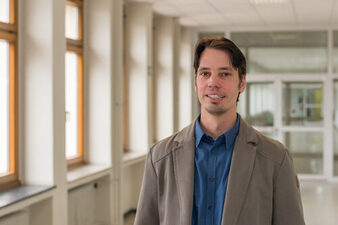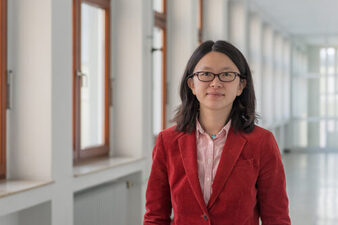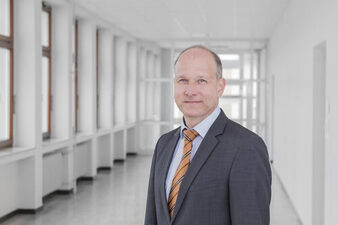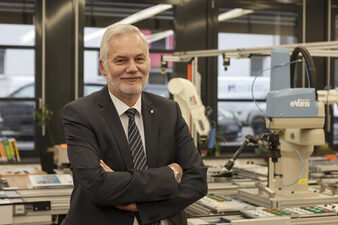When the robotics group(Opens in a new tab) at Dortmund University of Applied Sciences and Arts hosts its annual block week, interdisciplinary cooperation in the Master's program becomes particularly tangible in practice. Joint ideas and solutions were once again in demand in November 2023: students from the Faculties of Electrical Engineering, Computer Science, Information Technology and Mechanical Engineering tackled a challenging task in the field of rescue robotics.
The task
On the premises of the UAS's own Institute for the Digital Transformation of Application and Living Domains(IDiAL(Opens in a new tab) ), participants can expect a scenario based on a typical rescue robotics operation: A catastrophic event requires the deployment of external rescue teams, for example in a building that has been destroyed by fire or an earthquake. The operational environment is either fundamentally unknown, as no data on the building can be retrieved, or the environment has been changed by the disaster to such an extent that the existing maps can no longer be used. The location may be inaccessible or too dangerous for human emergency services. Nevertheless, it must be ensured that no persons or objects are trapped that need to be rescued.
In such scenarios, robots have been used to explore the surroundings and perform simple rescue tasks, and not just since the Fukushima disaster or the Notre-Dame de Paris fire. Of course, neither a fire nor a tsunami preceded the scenario of the block week, nor are radiation-proof rescue robots required. Instead, a new environment is constantly being set up in the robot laboratory at the Institute for the Digital Transformation of Application and Living Domains (IDiAL) using foam cubes and cardboard boxes. Three teams use so-called omnidirectional EduRobs, platforms that can move in any direction, to work on the relevant part of the task.
- The gripper team from the Faculties of Mechanical Engineering (lecturers: Alexander Lel and Prof. Dr. Thomas Straßmann) and Electrical Engineering is expanding the EduRobs to include a gripper that can be used to pick up and transport beverage cans as objects to be retrieved. The team is supervised and supported by Maximilian Becker (Electrical Engineering).
- The Navigation team from the Faculty of Computer Science (lecturers: Alexander Miller and Prof. Dr. Christof Röhrig) is working on adding a 360° laser scanner to the EduRob so that a map can be generated automatically. The high-precision sensor used captures the working environment and can take obstacles and walls into account. The maps created in this way later serve as the basis for targeted navigation. The laser scanner can also be used to detect and avoid new obstacles during navigation. The team is supervised and supported by employees Jan Erik Krüger and Lars Erbach.
- The Vision team from the Faculty of Information Technology (lecturers: Dr.-Ing. Tai Fei and Prof. Dr. Jörg Thiem) is responsible for recognizing the beverage cans to be recovered using a stereo camera (image recognition) and determining their relative positions. The drinks cans represent, for example, barrels containing hazardous substances that have to be recovered in a real rescue operation. The team is supervised and supported by employee Viktor Müller.
By integrating the work of the three teams, an overall system is created that maps an unknown environment and records the objects to be recovered. These are then retrieved with the gripper using the shortest route out of the dangerous situation and brought to safety. Lecturers Prof. Dr. Yan Liu and Prof. Dr. Andreas Becker are also on hand to provide all teams with ideas and tips during the block week.
Aim of the block week
By participating in the block week, students should learn and experience how interdisciplinary work on a complex task works. This involves, for example, self-organization within their own team to work on their own sub-project. Communication and final integration with the other teams is also an important aspect. In practice, purely homogeneous teams are rather rare, so interdisciplinary exchange is important in order to achieve the intended goal. In the chosen scenario, this is essential. The tight time frame of just five days alone does not allow any individual to deal with all aspects.
The Robotics WG block week thus builds a bridge between the Master's students from the participating faculties. It not only enables them to work within their own faculty, but also makes it necessary to create an integrated solution at the end of the week.
Course of the block week
After a joint kick-off event on Monday morning in the IDiAL meeting room, the students split into three teams. These work independently according to agile project management principles such as Scrum. Each team elects a team spokesperson who is responsible for the daily synchronization between the teams. A meeting of all students is planned for Friday, the last day of the block week. After a daily meeting of the individual teams and the exchange of information between the team spokespersons, the IDiAL rooms will again be used by all teams for integration. The aim: a final practical demonstration to conclude the block week. Afterwards, the results of the individual teams will be recorded and documented in the faculties' courses.
First day
The event will start in the rooms of the User Innovation Center (UIC) with a short presentation on the use of the Robot Operating System (ROS) as a common communication interface.
The first day of the block week is characterized by the review of the material provided and the collection of usable software libraries and ROS packages. The gripper team looks at some existing gripper concepts and can exchange basic ideas. The Navigation team takes the opportunity to record initial data sets with the EduRob's laser scanner to find out how well obstacles and walls are detected.
The Gripper team then moves on to the laboratories of the Faculty of Mechanical Engineering in the buildings at the Sonnenstraße location. The Vision team uses the IDiAL meeting room and a small office. The Navigation team can reserve the student room in the basement of IDiAL for themselves and can also discover the robot laboratory (also in the basement of IDiAL) for initial tests at short notice.
Second day
Once the basic procedure has been discussed, the teams embark on initial tests to tackle specific approaches.
The navigation team calibrates the EduRob's drive to improve dead reckoning (odometry) and support the algorithms for simultaneously localizing the robot and creating the map (Simultaneous Localization and Mapping, SLAM for short). This allows various ROS modules for implementing SLAM procedures to be tested. For this purpose, the environment set up in the robot laboratory is redesigned several times. The tested methods differ particularly in the exploration part of the unknown environment and require an adjustment of the parameters in order to be able to assess the accessibility of new parts of the map.
In the Vision team, camera images are captured with both cameras of the stereo camera. The recognition and classification of objects (the beverage cans) is the initial focus. However, the merging of both camera images for depth information is also a work package that is already underway.
Third day
At the global coordination meeting of the team speakers on the third day, important parameters such as the dimensions of the gripper will be coordinated - valuable information both for navigation, for determining passable corridors in the map, and for the recognition of objects by the Vision team with regard to the distance to the objects before gripping.
The electrical and information technology interface between the gripper team and the navigation team is developed and tested using an existing gripper. As the final gripper uses the same motor, it has already been possible to carry out preliminary work in this way, which should speed up integration on the final day.
The Vision team also uses the environment set up by the Navigation team for tests in a real environment. For this purpose, an EduRob is equipped with the stereo camera and placed in the scenario together with objects. IDiAL's network infrastructure enables access from the meeting room on the second floor to the network of the robot laboratory in the basement.
The Navigation team analyzes and overcomes any errors that occur when controlling the drive. For this purpose, the team sets up a route in the robot laboratory that is measured with a tape measure. The EduRob can repeatedly drive along sections of the route that are marked with small FH cubes. This makes it possible to check and track the improved calibration of the drive. The recording of distances travelled by the drive serves to optimize the localization and navigation algorithms, which thus have a second data source in addition to the laser scanners.
This allows all teams to make good progress on the third day and make plans for the last full working day before the upcoming integration.
Penultimate day
The three teams use the fourth day of the block week primarily to refine their chosen approaches.
The Navigation team adds objects to the environment in order to test the detection of cans in the data provided by the laser scanner. This makes it possible to add coordinates to the classification data obtained by the Vision team.
In the Vision team, the scenarios were expanded to include so-called ArUco markers, which can be used as known reference elements for better evaluation of the camera images obtained.
The Gripper team can have the first gripper prototype produced (rapid prototyping). The 3D files, which were previously created using the CAD system, are produced in a 3D printer from the material PLA (polylactide) and the gripper fingers from the elastic material TPU (thermoplastic polyurethane) (using additive manufacturing).
Integration Day and presentation
At the end of the block week, all teams meet one last time for their internal dailies. The aim is to prepare for the upcoming final integration with the other teams. Also in the last meeting of the team spokespersons, the time of the presentation is set for 4 pm with a trial run at 3 pm.
The gripper team can use the 3D printer in the IDiAL workshop to produce the final parts of the gripper, assemble the final version of the gripper on site and finally present it to the other teams.
The practical part of the final presentation is then rehearsed in several test runs and final changes are made.
The hybrid presentation starts at 4 pm. While the majority of the participants in the block week have gathered in the robot lab, other participants are connected via an online meeting. First, the Navigation team presents the exploration of the unknown environment and the creation of the map. In the second step, the objects to be detected and retrieved are added in the form of beverage cans. They can be successfully located and grabbed.
Finally, the Vision and Gripper teams give detailed presentations on the selected approaches and their strengths and weaknesses.
To the Robotics-AG
The Robotics Working Group is an interdisciplinary working group at Fachhochschule Dortmund that deals with all aspects of robotics in research and teaching. The individual faculties contribute their particular strengths and skills. The robotics working group regularly organizes the robotics block week at IDiAL. The Robotics Forum also takes place at Fachhochschule Dortmund, which in 2023 highlighted the topic of robotics in detail on the second day of the block week with the 8th Robotics Forum and three exciting lectures.
To the IDiAL
As the central scientific institution of Fachhochschule Dortmund, IDiAL conducts research into digital transformation. Offices, laboratories and a workshop are operated for this purpose at Otto-Hahn-Straße 23 in Dortmund. For the Robotics Block Week 2023, rooms of the User Innovation Center (UIC), the robotics laboratory of the Institute for the Digital Transformation of Application and Living Domains (IDiAL) and the Institute's workshop were used in addition to a meeting room and a workroom for student work.
In addition to the annual block week, IDiAL conducts research in several robotics-related projects. As part of these research projects, students also work on final theses in the Bachelor's and Master's study programs in the Faculty of Computer Science.
Participating courses
- The Navigation team consisted of 8 students from the Faculty of Computer Science, who were able to put the module content into practice during the block week as part of the Master's module "Autonomous Mobile Systems".
- The gripper team consisted of 9 students from the Faculty of Mechanical Engineering, who took part in the block week as part of the Master's module "Robotics and Handling Technology". The gripper team was supported by a student assistant from the Faculty of Electrical Engineering.
- The Vision team consisted of 9 students from the Faculty of Information Technology who took part in the block week as part of the Master's module "Advanced Robotic Vision".
Contact person
Prof. Thomas Straßmann, Dr.
- +49 231 91129334
by arrangement by email





